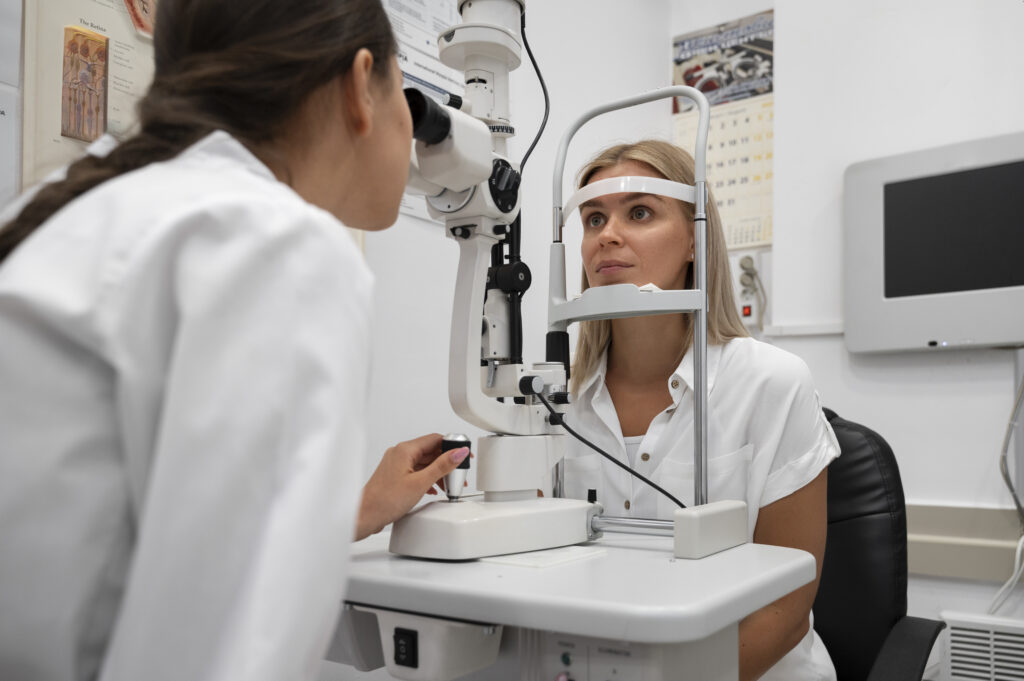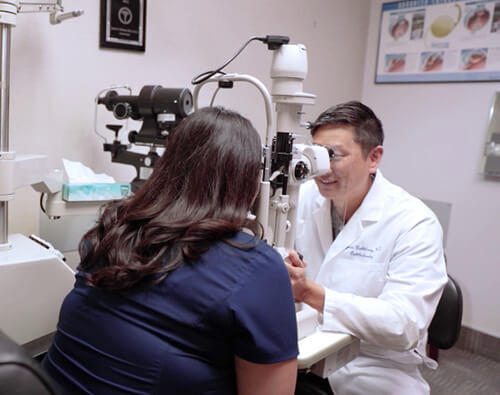Many serious eye conditions develop silently, without obvious symptoms. By the time you notice blurry vision, eye strain, or other warning signs, irreversible damage may already be done. That’s why early detection through a comprehensive eye exam is one of the most important steps you can take to preserve your vision and overall health.
At Pacific Eye Institute, we believe in proactive eye care. Although we specialize in advanced treatments and surgeries, we do not perform comprehensive eye exams. Instead, we recommend that patients visit their local optometrist for these exams. If an issue is detected, our ophthalmologists are here to help with expert-level care.
What Is a Comprehensive Eye Exam?
A comprehensive eye exam is much more than just checking if you need glasses or contact lenses. Conducted by a licensed optometrist, it involves a series of tests to evaluate your visual acuity and overall eye health. These exams are essential not only for vision correction but also for detecting a wide range of health conditions, many of which show no early symptoms.
A comprehensive eye exam includes:
- Medical and Vision History Review – Evaluates your overall health, current medications, and any eye-related symptoms.
- Visual Acuity Test – Measures how clearly each eye can see letters or symbols on a chart.
- Refraction Assessment – Determines your lens prescription if you need glasses or contacts.
- Eye Movement and Coordination Test – Checks how well your eyes work together.
- Slit-Lamp Examination – Provides a magnified view of the eye structures such as the cornea, iris, and lens.
- Intraocular Pressure Test (Tonometry) – Screens for glaucoma by measuring the pressure inside your eyes.
- Dilated Eye Exam – Allows the optometrist to see the retina and optic nerve, often using advanced imaging tools.
- Peripheral Vision Testing – Detects early signs of glaucoma or neurological issues.
Eye Conditions That Can Be Detected Early
Routine eye exams can detect a wide variety of conditions, including:
- Glaucoma – Known as the “silent thief of sight,” glaucoma often has no early symptoms. Eye pressure tests and optic nerve evaluations can detect it before permanent damage occurs.
- Cataracts – Clouding of the eye’s lens that can lead to blurry vision and glare. Cataracts are treatable with surgery, but early diagnosis ensures proper timing.
- Macular Degeneration – An age-related disease that affects central vision. Early signs can be detected with retinal imaging.
- Diabetic Retinopathy – Caused by diabetes, this condition damages retinal blood vessels and can lead to blindness if not caught early.

- Refractive Errors – Such as nearsightedness, farsightedness, and astigmatism, which can impair daily life and cause headaches or eyestrain.
- Retinal Detachment or Tears – These can begin with floaters or light flashes, and early detection is key to preventing serious vision loss.
- High Blood Pressure or Hypertension – Changes in blood vessels in the retina can be an early indicator of hypertension.
- Autoimmune Disorders and Allergies – Dry eye and chronic redness can be linked to systemic issues like rheumatoid arthritis or allergic reactions.
- Skin Cancer Around the Eyes – During the external exam, optometrists can detect abnormal lesions or growths near the eyes that may be cancerous.
Why Being Proactive Matters
Many eye diseases are irreversible once vision is lost. That’s why proactive care is so important. Eye exams not only help prevent vision loss, but they also improve quality of life by catching systemic conditions that affect your overall health.
Children with uncorrected vision issues may struggle with reading and learning. Adults may not realize their headaches or fatigue are caused by eyestrain. Seniors who delay care are more likely to suffer from vision-related falls, loss of independence, or depression.
Being proactive means getting ahead of the problem. Don’t wait until symptoms appear. By the time you experience blurry vision or eye discomfort, permanent damage may already have occurred.
What You Can Do Now

The American Optometric Association recommends:
- Infants: First eye exam at 6 months
- Children: Additional exams at age 3 and before starting school
- Adults under 60: Eye exams every 1–2 years
- Adults 60 and over: Annual eye exams
If you haven’t had a comprehensive eye exam recently, now is the time to schedule one with your local optometrist. If your optometrist finds a medical condition that requires specialized treatment, Pacific Eye Institute is here to provide expert care.
We offer advanced services including cataract surgery, LASIK, retina care, glaucoma treatment, and more. But the first step in protecting your vision begins with a comprehensive eye exam outside of our clinic.
Serving Communities Throughout Southern California
Pacific Eye Institute is proud to serve patients from across the Inland Empire and surrounding areas. Click to visit our locations. No matter where you live in Southern California, expert eye care is within reach.
Conclusion
Your eyes deserve the same care and attention as the rest of your health. Comprehensive eye exams play a critical role in catching vision problems and systemic diseases early. Visit your local optometrist for your routine eye exam, and if additional care is needed, the trusted team at Pacific Eye Institute is ready to help.
Take control of your vision and your health—be proactive. Call (800) 345-8979 or visit our website to learn more about how Pacific Eye Institute can support your eye care journey.








